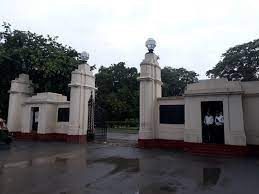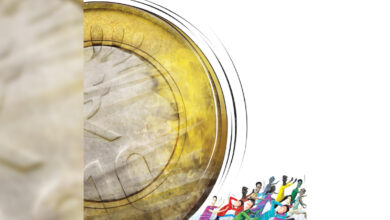Opinion | India in 2024: Visions, Goals, Plans, and Initiatives
BANG OF ROCKETRY
2024 has just got underway. However, India has already begun to hunt, having launched itself into a high trajectory with a spectacular boom. India pole-vaulted on January 1st, becoming the second nation in the world to launch the XPoSat (X-ray Polarimeter Satellite) to research celestial phenomena such as black holes, after the United States.

India is well on its way to becoming a $4 trillion economy this year, with a forecast GDP growth rate of between 6.5 and 7%, or more than twice the world growth rate. The nation is expected to surpass the budget forecasts for FY2024 after a stunning 10% growth in GST collection in December to a total of Rs 1,64,882 crore.
Well in advance of the event marking the official opening of Ram Mandir and the beginning of a new chapter in the history of religious and spiritual travel both domestically and internationally, “Pushpak Viman” made his first contact with the Maryada Purushottam Shri Ram Airport tarmac.
In this election year, Prime Minister Modi has shied away from populism, and the administration has steadfastly refused to raise the interest rate on modest savings plans.
The aforementioned portends well for India in 2024.
VERDICT TIME
2024 is set to be an election year, with the April–May Lok Sabha elections. Since the Indian voters might be unpredictable, I have no political punditry. However, as a careful watcher of the evolving national landscape, I have calculated that the return of Modi 3.0 is almost a given, regardless of whether the BJP’s new slogan, “Teesri baar Modi sarkar, abki baar 400 paar,” materializes, whether it secures a simple majority like it did in 2014, or whether it forms a government with the NDA. This calculation is based on the performance perception of ten years of Modi Raj, the shattered opposition, recent survey reports, and some hard data analysis.
Modi 3.0 takes into account my goals, objectives, and agenda for India in 2024. Furthermore, even in the improbable event that the Opposition wins, the plan I provide below is still my guide for turning 2024 into a turning point that would launch India’s development toward development by 2050, if not 2047.
GOALS, ASPIRATIONS, AND PURPOSE
My six-year perspective serves as the pivot for my bold goals (25 years), aspirational aspirations (5 years), and realistic plan agenda (1 year). And they center on
revolutionary expansion of the economy
The realization of the goal of a continuous 25 years of sustained yearly GDP growth of more than 10 percent must be woven throughout the minimal requirements for becoming a developed country. India is leading the way, having broken the mold with a GDP growth of over 8% in 2024 and over 9% in aspirational growth over the following five years.
Moving forward and achieving a high per capita income
In terms of per capita income, India ranks 139th by nominal GDP and 127th by PPP, despite the fact that it is expected to surpass the latest IMF prediction and become the world’s third largest economy in 2027 (with an estimated economy size of $5.4 trillion). With a five-year goal of breaking into the top 100, the ideal scenario would be to propel per-capita income to the 25th place in 25 years. From the current $2,450 per capita income to $12,670 in China and $47232.27 in the UK, this will need a massive rise. It’s a long, winding route seldom traveled, and the purposeful trip with a determined action plan has to start in 2024.
Closing the enormous disparity in wealth
With 144 crore people, India has just been or will soon become the world’s most populous nation. Furthermore, by 2050, the population is expected to have increased to 166.8 crore. This implies that unless there is a purposeful, measured, well-defined approach to enormous poverty reduction with well-targeted distributive justice, the increase of per capita income will be severely pressured. Over the last 15 years, India has successfully lifted 415 million people out of the poverty trap, demonstrating the multifaceted nature of the issue. Even yet, the nation is home to the greatest number of impoverished people in the world, who make do on $2.15 or less a day. Shankhnaad year 2024 is necessary to eradicate absolute poverty by 2050.
Benefiting from the population dividend
A significant portion of the industrialized world’s North and the populations of China, Japan, and South Korea are aging and decreasing, but India is a young nation that will experience the longest-lasting demographic dividend of any nation for many years. In the next 25 years, India’s demographic dividend will be crucial to its development into a developed nation. Nevertheless, there are several obstacles in the way of enjoying the population dividend. In order to get the nation where it needs to go by 2024, a modular, attainable route that turns headwinds into tailwinds must be created.
From job searchers to producers of wealth
Since Macaulay’s educational system took root in India, the nation has seen a surge in the number of job seekers who are unemployable due to lack of knowledge, including illiterate, literate, and educated individuals. Despite the relative decline in unemployment, an unemployment rate of around 10% is always possible, according to a quick examination of CSSO and CMIE figures. India has to become the center of millions of young disruptors who can turn the country from one with millions of unemployed to one with millions of wealth producers and employment providers in an age of declining government and public sector jobs. That is the way the dream of a developed nation may come true in the next twenty-five years.
Sustainability of the environment and ecology
The first step in realizing the 25-year objective of becoming Samarth, Atma-Nirbhar Viksit Bharat is to integrate development with ecological and environmental sustainability on both the intra- and intergenerational levels. The topic has been the subject of much too much sabre-rattling, fits, and puffing. However, sustainability is now a matter of survival rather than desire. Now is when the time begins.
ACTION POINTS
In order to make the aforementioned goals, objectives, and visions a reality, India has to immediately embark on the 11 action items listed below.
Reforms of the fourth generation
Socialism and the licensing permission raj cost India decades. The nation has not quite escaped the shackles of the past, even after three generations of reforms led by Manmohan Singh, Atal Bihari Vajpayee, and two terms of Narendra Modi. The fourth generation of multi-pronged changes that span sectors should now be implemented. And the clock starts on February 1st, when the current administration makes its last budget-cum vote of accounts presentation. Unfazed by the Kaun Banega Pradhan Mantri scandal, which rejected all forms of populism, it’s time to present the new reform plan and awaken the beast inside.
Infrastructure
The main grievance with India as we ushered in the new century was its aging infrastructure. During the Vajpayee period, infrastructure renewal started, slowed down during the UPA era, and changed throughout the past 10 years. But the reality is that many infrastructural fantasies must be woven together and realized if the nation is to become a developed one in 25 years. Infrastructure has the potential to boost GDP growth by an extra 2% annually. There is a huge demand for infrastructure, and these three have been chosen:
Long-distance multimodal transportation
Rapid infrastructure development for cross-country transportation is essential for the efficient, effective, and quick movement of people and products. The expansion of transportation infrastructure throughout the last 20 years has been uneven and skewed more in the direction of roads and highways. India has to challenge the status quo in 2024 and commit to tripling the length of its railway network from 70000 km to 210000 km over the course of the next 25 years. This includes constructing 20,000 km of freight corridors, 2,000 km of high-speed passenger corridors (300–350 kmph), and 60,000 km of semi-high-speed corridors (250 kmph).
In the same time frame, the nation must expand the number of operating public airports from 150 (Ayodhya being the most recent) to 1000 (the United States now has 5000 public airports and over 10,000 private airports). Additionally, it must significantly increase the capacity of ports and coastal waterways and double, if not treble, the number of four-lane roads and expressways.
The nation will need a new time-bound, ultrafast execution discipline in order for things to be accomplished. Prior to that, the construction of the Ram Temple in Ayodhya in record time has shown that, with enough will, everything is possible. This is demonstrated by the new Parliament building.
Ecological city transportation
Currently, over 50 crore Indians reside in cities and towns and contribute 66% of the country’s GDP; this figure is expected to drastically shift to over 85 crore city inhabitants providing almost 80% of GDP. India will need hundreds of new cities in addition to a significant growth in the population of its present cities. India’s cities have congested transit. Due to their lack of infrastructure, walkers and cyclists—who make up around 50% of trips—suffer the most. To achieve symbiotic growth and integration of multimodal sustainable urban mobility, the whole paradigm of urban transportation must be altered.
It involves more than just adding metro rail; rather, it calls for every city to have a full hierarchy of pleasant, economical, and sustainable infrastructure, based on its size and pattern of transportation.
Water, wherever there is water, nowhere there is water
Without a doubt, the world’s largest consumer of groundwater, India, is facing an existential water catastrophe. Just 4% of the people in this nation, which is home to 18% of the world’s population, has access to fresh water. Pollution and serious depletion of the groundwater table are present. Furthermore, either too little rain (drought) or too much rain (flood) results from global warming. The nation must reconsider and reassess its water future, with 2024 serving as a guide. The water situation is crucial for many areas of the economy, not only agricultural and drinking water.
Farming
Although it only makes up 18% of the GDP, more than 60% of the nation’s population is dependent on agriculture, forestry, and fisheries. Even worse, there is severe rural unemployment and underemployment and agriculture is operating at a subsistence level. India will need to become an export center in addition to radically changing its agricultural methods in order to feed its 160 crore people over the next 25 years. Not much has changed in Indian agriculture since the Green Revolution of the 1960s, and Rome was not built in a day. The agricultural and economic resurgence must start in 2024.
Producing
The industry’s Gross Value Added in FY23 was 28.25 percent; the breakdown was as follows: 2.36 percent went toward mining and quarrying, 8.19 percent went toward construction, and 14.7% went toward manufacturing. For India’s hopes and ambitions, it does not seem promising. This presents a chance. China’s population is aging and decreasing, and the country’s economy has been straining even since COVID-19. Westerners are removing their industries and money from China. However, there is fierce rivalry among emerging countries; every nation, from Bangladesh to Vietnam, is vying to become the global manufacturer. Let India’s ambition to become the world’s factory begin in 2024 by laying the groundwork and red carpet.
Services
Services constitute the mainstay of the Indian economy, accounting for a staggering 53.34 percent of GDP. Public administration, defense, and other services (13.91%), financial real estate and professional services (21.42%), and trade, hotels, transportation, communications, and broadcasting-related services (17.98%) are the subsectors of the services that contribute in relation to each other. This is where the dice is cast. The Indian economy has the potential to develop far faster in this sector. The nation has skilled labor, raw supplies, and a global market.
The warning is that the proportion of defense and administration in the expanding pie must decrease. Furthermore, India must innovate in order to continue leading the world in the services sector; it can no longer compete in the “knowledge economy” just on the basis of price. India has to become a commercial and tourist attraction as well. In these domains, 2024 needs to recalculate the dream to roughly correspond with 2050.
Utilization
The primary driver of development in this unstable environment of rising nationalism and waning globalization must be domestic spending. However, there isn’t a secret sauce for raising consumption. The only way to boost the consumption basket is to quickly raise disposable income, and the key to doing so is a rise in real wages in both cities and villages.
Creativity
India requires sustained disruptive double-digit development for decades in order to become a developed nation; incremental growth is not enough. And that’s where my desire of invention enters in. When it comes to innovation, the US and China lead the globe. China has moved smoothly from being the global center of production to being an innovation environment. In the words of the world’s renowned management guru, the late Coimbatore Krishnarao (CK) Prahalad, India has to not only emulate China but also take a stride forward on the innovation superhighway with its own “next practices.”
Instruction
It is not difficult to figure out that, in spite of a few isolated centers of brilliance, the nation’s educational system is appalling. Even though it began with much fanfare, skilling hasn’t really taken off. India must significantly step up its efforts to ensure that both the rich and the poor have access to high-quality education, to annually produce the necessary amount of human capital, to fulfill its dream of becoming the global hub for the knowledge economy, to become a factory of the world, and to export the greatest number of highly qualified Indian professionals to manage the economies of the greying and contracting developed countries.
Well-being
India’s health is in a state of existential crisis, if not outright unconsciousness. With 143 crore people, the health budget of Rs 88,956 crore from the previous year is insignificant. The difference becomes much more noticeable if we take off the setup expense from the budget. The crisis affects all aspects of preventative, curative, and palliative care as well as primary, secondary, tertiary, and research. Human capital, infrastructure, equipment, and materials are severely lacking.
Thus, it should come as no surprise that, despite the untrustworthy official figures, the nation’s out-of-pocket health spending has decreased from 62.6% in 2014–15 to 47.1% in 2019–20. The allotted time has passed.
Eliminating pollutants
India’s air pollution problem is killing people; estimates ranging from ambient to interior pollution point to about 2.1 million fatalities annually. Both the impacts and the pollutants are well understood. Our issue is that neither we nor our curiosity are aware of the degree of contamination. The most dangerous pollutant, ambient PM2.5, is present in unsafe amounts to all 144 crore people in India. Additionally, according to estimates from 2019, the whole economic loss to the Indian GDP is $37 billion, or 1.4% of GDP. For the country, it is a “Wake Up, Sid” moment.
lowering the level of corruption
A country has to become less corrupt before it can advance in development. Out of 185 nations, India ranks 85th on the Transparency International Index. As a banker, civil servant, public sector senior business honcho, social worker, and impact consultant throughout the course of my 45 years in the public eye, I have seen firsthand the naked dance of both retail and wholesale corruption’s ascent. The termite symbolizes corruption. It’s time to put an end to it. Let 2024 get off to a great start with zero tolerance for corruption and lightning-fast punishment for those who do it.







